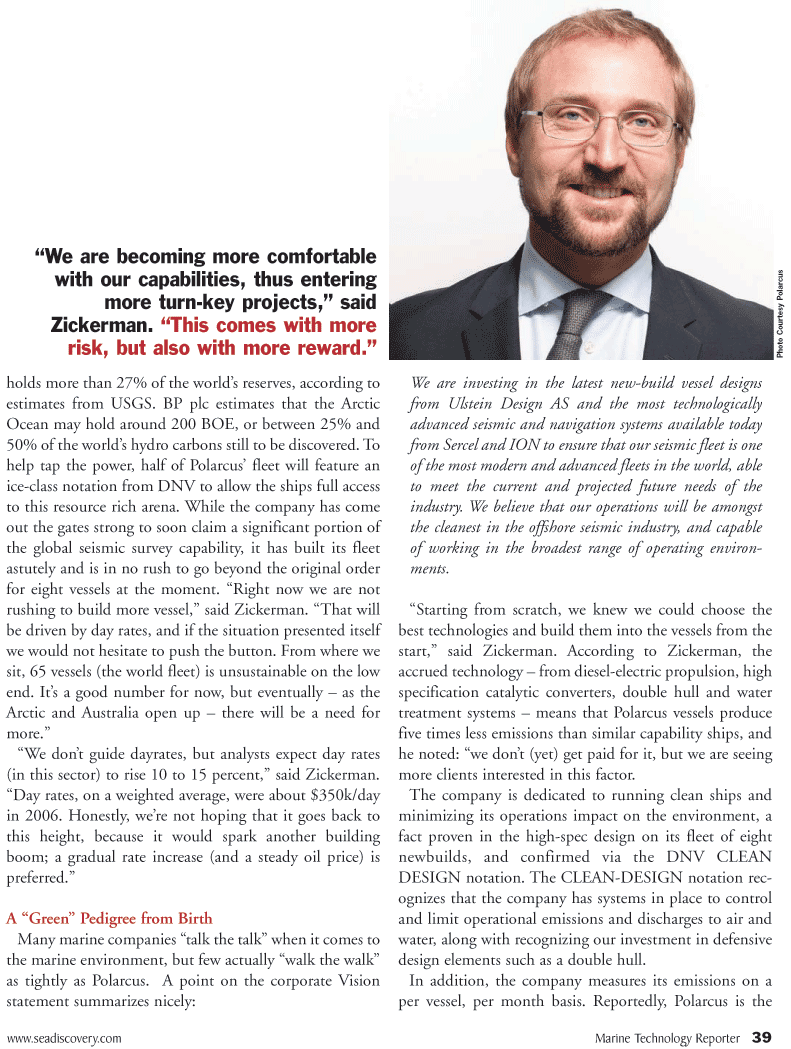
Page 39: of Marine Technology Magazine (April 2011)
Oil & Gas SubSea Monitoring
Read this page in Pdf, Flash or Html5 edition of April 2011 Marine Technology Magazine
www.seadiscovery.com Marine Technology Reporter 39 holds more than 27% of the world’s reserves, according to estimates from USGS. BP plc estimates that the Arctic
Ocean may hold around 200 BOE, or between 25% and 50% of the world’s hydro carbons still to be discovered. To help tap the power, half of Polarcus’ fleet will feature an ice-class notation from DNV to allow the ships full access to this resource rich arena. While the company has come out the gates strong to soon claim a significant portion of the global seismic survey capability, it has built its fleet astutely and is in no rush to go beyond the original order for eight vessels at the moment. “Right now we are not rushing to build more vessel,” said Zickerman. “That will be driven by day rates, and if the situation presented itself we would not hesitate to push the button. From where we sit, 65 vessels (the world fleet) is unsustainable on the low end. It’s a good number for now, but eventually – as the
Arctic and Australia open up – there will be a need for more.” “We don’t guide dayrates, but analysts expect day rates (in this sector) to rise 10 to 15 percent,” said Zickerman. “Day rates, on a weighted average, were about $350k/day in 2006. Honestly, we’re not hoping that it goes back to this height, because it would spark another building boom; a gradual rate increase (and a steady oil price) is preferred.”
A “Green” Pedigree from Birth
Many marine companies “talk the talk” when it comes to the marine environment, but few actually “walk the walk” as tightly as Polarcus. A point on the corporate Vision statement summarizes nicely:
We are investing in the latest new-build vessel designs from Ulstein Design AS and the most technologically advanced seismic and navigation systems available today from Sercel and ION to ensure that our seismic fleet is one of the most modern and advanced fleets in the world, able to meet the current and projected future needs of the industry. We believe that our operations will be amongst the cleanest in the offshore seismic industry, and capable of working in the broadest range of operating environ- ments. “Starting from scratch, we knew we could choose the best technologies and build them into the vessels from the start,” said Zickerman. According to Zickerman, the accrued technology – from diesel-electric propulsion, high specification catalytic converters, double hull and water treatment systems – means that Polarcus vessels produce five times less emissions than similar capability ships, and he noted: “we don’t (yet) get paid for it, but we are seeing more clients interested in this factor.
The company is dedicated to running clean ships and minimizing its operations impact on the environment, a fact proven in the high-spec design on its fleet of eight newbuilds, and confirmed via the DNV CLEAN
DESIGN notation. The CLEAN-DESIGN notation rec- ognizes that the company has systems in place to control and limit operational emissions and discharges to air and water, along with recognizing our investment in defensive design elements such as a double hull.
In addition, the company measures its emissions on a per vessel, per month basis. Reportedly, Polarcus is the “We are becoming more comfortable with our capabilities, thus entering more turn-key projects,” said
Zickerman. “This comes with more risk, but also with more reward.”
Photo Cour tesy Polar cus

 38
38

 40
40
